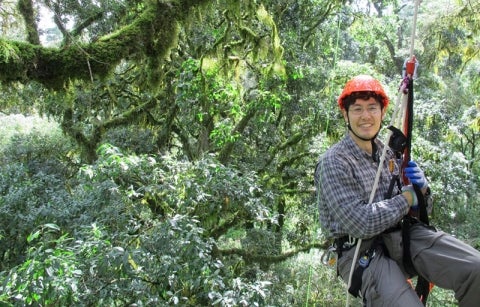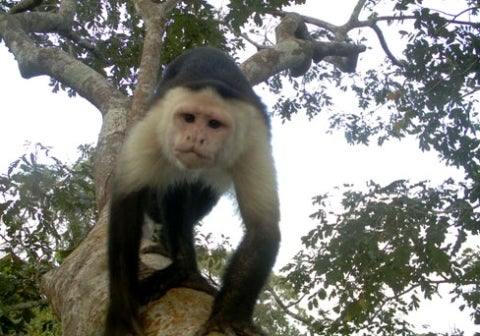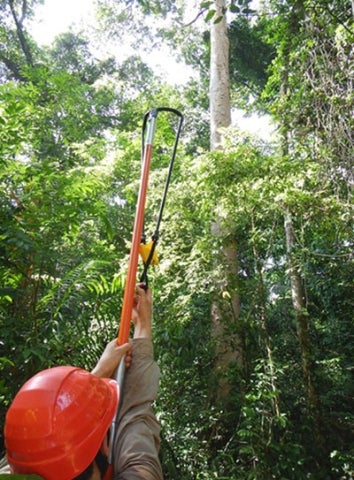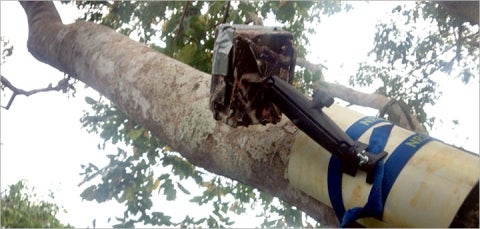Note: Yale School of the Environment (YSE) was formerly known as the Yale School of Forestry & Environmental Studies (F&ES). News articles and events posted prior to July 1, 2020 refer to the School's name at that time.

He calls these pathways “canopy highways.” And what he learns about these routes, located some 70 to 100 feet above the forest floor, could help conservationists protect monkeys and a range of other species that are rarely seen and can be nearly impossible to study.
In addition to collecting a trove of data, McLean is also blogging about his trip and sharing photos and videos in near real time.
In this interview, McLean talks about what he’s trying to learn in Panama, some of the hazards he’s encountered in the forest, and why he decided to blog about it. Beyond simply letting his family and friends know what he’s up to, McLean says the blog offers a valuable opportunity to share the scientific process with a wide audience.
“Research publications often downplay or eliminate altogether the intricacies of how research is actually done, the effort that goes into each data point,” he says. “I think this is where the most fascinating stories and experiences in science come from and I wanted to try to do something that might bring that to whoever wants to see it.”
Can you describe the work you’re doing in Panama?
I am down in Panama on Barro Colorado Island, a research reserve operated by the Smithsonian Tropical Research Institute. The work I’m doing is part of my dissertation research, which is focused on how arboreal (tree-dwelling) animals move through the rainforest canopy. I am interested in why some animals choose to repeatedly use the same pathways, which are sometimes called “canopy highways,” and how they are chosen. For about 12 weeks I will be setting up 90 motion-sensitive cameras in the treetops to try to detect mammals that are rarely seen in traditional wildlife censuses.
 Tree-mounted cameras have already revealed a busy thoroughfare along one of McLean’s targeted “canopy highway” routes. This video at right captures a variety of species — including kinkajous, three-toed sloths, and white-faced capuchin monkeys — at one location. “I could hardly contain my excitement when we looked through all these photos,” McLean <a href="http://www.kevin-mclean.com/1/post/2014/02/surrounded-on-all-sides.html">writes on his blog</a>.
Tree-mounted cameras have already revealed a busy thoroughfare along one of McLean’s targeted “canopy highway” routes. This video at right captures a variety of species — including kinkajous, three-toed sloths, and white-faced capuchin monkeys — at one location. “I could hardly contain my excitement when we looked through all these photos,” McLean <a href="http://www.kevin-mclean.com/1/post/2014/02/surrounded-on-all-sides.html">writes on his blog</a>.
Video of Canopy Traffic
Over the past year or so I have been working on a computer model that aims to predict which areas are most suitable for arboreal movement based on the three-dimensional structure of the forest. I am choosing my deployment sites based on the model results in hopes that the detections I get from the cameras will validate the predictions of the model. That is, I’m hoping to see more animals in areas that my model says are best for movement.
Setting up cameras at these heights seems somewhat treacherous.
I wanted to choose a research topic that would let me work my core while completing my dissertation. I started off sitting on a yoga ball while I typed. This was my second idea.
In all seriousness, though, there are definitely a lot of risks involved with this field work, but getting up into the canopy is really the only way to get a sense of what is going on up there. As ground-dwelling species ourselves, we have historically neglected to look up when studying the forest.
Getting up into the canopy is really the only way to get a sense of what is going on up there.
The tree climbing has been the most time-consuming training. Well, that’s not true — learning how to use all the software to model movement behavior took forever and I’m still learning more about it. I sought out a fair bit of tree-climbing training because I knew that the work I was going to be doing would require a lot of lateral maneuvering once I got up into the tree, which takes a lot of practice... I took a two-day introductory course at Yale Myers Forest with some other F&ES students. I also took a four-day basic course in Oaxaca, Mexico at the 6th International Canopy Research Conference, and a three-week course in Bocas del Toro, Panama at the Institute for Tropical Ecology and Conservation. There are only a handful of certified Master Tree Climbers and I’ve gotten a chance to train under two of them (Tim Kovar of Tree Climbing Planet and Joe Maher of Tree Climbers Coalition), which has been a fantastic experience.
What have you found so far?
At the moment I’m waiting to collect most of the cameras that I’ve deployed (45 cameras in 15 trees so far), but I collected some pilot data last year as I was testing out my climbing and camera deployment methods in preparation for this year. The data are limited, but one of the basic findings was that the majority of documented activity occurred at night, meaning that the arboreal mammals are even more likely to evade detection by human surveys. This definitely highlights the need for work to be done actually in the canopy. Also, I found quite a few different species — climbing rats, monkeys, opossums — using the same branches to get from one place to the next, which may indicate that there are some common features that animals select when they choose a path in the canopy.

Oh goodness, there have been quite a few. In order to climb into the tree I use an 8-foot-tall slingshot to shoot a little beanbag attached to a string around a branch, then tie my rope to the string and pull it over the branch. This in itself is a bit of a hazard because I’m not great with the slingshot. You also never really know what’s going to greet you once you get into the tree. Just the other day I got the string up and as I was working to get the bag back to me there was a black cloud of bees that exploded out of the branch above my string. Africanized “killer” bees are a bit of a problem in this area and this certainly fit the description of a swarm of them. I almost started running for cover, but luckily the swarm buzzed away in another direction.
Other than that, ticks and ants are the worst. I don’t want to be negative, but I hate them both. Sorry, that was negative.
Any other surprises so far?
Well, I just collected the first three cameras and I got three species that have never shown up on my cameras before — spider monkeys, howler monkeys, and a three-toed sloth. I guess it shouldn’t be a surprise, but I was so excited to actually see some animals in the photos. I’ve been having nightmares about all the cameras failing to work properly, filling up with useless photos with no animals (sometimes branches moving in the wind set them off), or falling out of the tree. All these things could still happen with the rest of the cameras, but it really feels great to have a few decent photos in hand already.
What are the greatest threats facing these species?
Well, at the risk of sounding shamelessly self-important, I would argue that one of the biggest threats to these animals is a lack of knowledge about them and their habitat. Monkeys are fairly conspicuous and their populations can be monitored, but many of the nocturnal species are rarely seen and thus we know very little about their numbers and how they respond to development and human activities in the forest. Habitat loss due to development and deforestation is a huge concern for all animals, but with arboreal species we don’t even know yet what makes for good or bad habitat in the treetops.
Assessments of habitat quality are typically done through ground-based methods. And while they may be somewhat related, no one knows whether high-quality habitat on the ground means there is high-quality habitat in the canopy. We think in great detail about where reserves are placed on the landscape two-dimensionally, but in order to ensure that the largest possible suite of species can be protected within a given area, you need to have an understanding of how the entire forest is used by its inhabitants in three dimensions.
A few very wise people reminded me that there are some things that will always be beyond my control, but I have spent a lot of time planning and thinking about things that I can control.
From a scientific perspective, I also wanted to try to do something that would share the process of my work with people. Research publications often downplay or eliminate altogether the intricacies of how research is actually done, the effort that goes into each data point. I think this is where the most fascinating stories and experiences in science come from and I wanted to try to do something that might bring that to whoever wants to see it.
What do you hope you’ll come away with from your weeks in the forest?
This is one of the things that I’ve battled with as I prepared for this trip, because there are so many things that could go wrong. I worried that I wouldn’t be able to find the right trees, the trees would be too challenging to climb, the cameras wouldn’t work like they did last year, or even if they did work they might not validate the model. I had to realize that even if one or all of these things came true it wouldn’t be a complete failure of the project as a whole or me as a student. A few very wise people reminded me that there are some things that will always be beyond my control, but I have spent a lot of time planning and thinking about the things that I can control. The best-case scenario would be that I come away with a lot of great photos, validated scientific findings, and a truly unparalleled experience. I suppose it is comforting to know that at least one of those is guaranteed.

